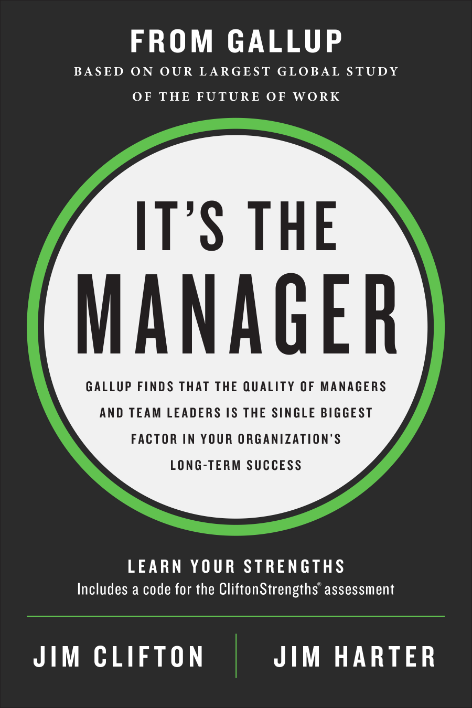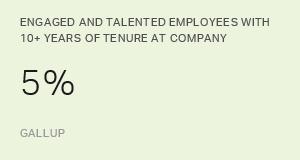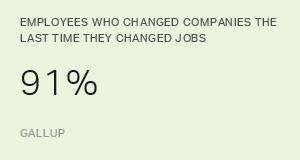Story Highlights
- The quit rate of U.S. employees is at a record-breaking high
- Employees have the competitive edge in today's job market
- Develop a strong employee experience that makes employees want to stay
The percentage of U.S. employees quitting their jobs is at an all-time high -- more evidence that the practice of management is broken.
The quit rate -- the rate at which employees voluntarily leave their jobs -- is 2.3%. This is the highest it's been in 15 years and the third-highest rate recorded since the government began tracking it in 2000. That number has remained unchanged for 11 straight months, from June 2018 through May 2019, making this the longest static period for the rate on record.
Not coincidentally, Gallup data show that 67% of U.S. employees are disengaged at work, 51% say they're actively looking for a new job or are open to one, and 47% say now is a good time to find a quality job.
The data are clear: U.S. businesses are in a full-fledged talent war and employees have the edge -- the demand for jobs exceeds the supply of workers, and employees are confident about their chances. To mitigate the impact of talent loss, companies need to establish a strong employee experience that makes their employees want to stay.
"The solution lies in aligning the practice of management with the new will of the world's workers," states Gallup's latest bestseller It's the Manager. The 52 discoveries in the book are based on reviews and evaluations of our client databases boasting more than 60 million employees as well as other large-scale meta-analyses containing hundreds of studies on goal setting, feedback, engagement, individual differences and competencies.
Gallup data show that 67% of U.S. employees are disengaged at work, 51% say they're actively looking for a new job or are open to one, and 47% say now is a good time to find a quality job.
Both quantitative and qualitative, our research uncovered the factors that drive today's workers to stay or quit. Chief among them is the discovery that workers, particularly millennials, are far less motivated by pay -- though it's still important -- than by an employee experience that aligns with their lives and personal purpose. In brief:
1. Millennials and Generation Z want purpose.
Their work must have meaning. They want to work for organizations with a mission and purpose. Compensation is important and must be fair, but it's no longer their primary motivation.
2. Millennials and Generation Z seek development.
Most members of these generations don't care about the bells and whistles in many workplaces today -- the pingpong tables, fancy latte machines and free food. "Giving out toys and entitlements is a leadership mistake," reveals It's the Manager. "And worse, it's condescending."
3. Millennials and Generation Z want coaches, not bosses.
Millennials and Generation Z need team leaders who can coach them, who value them as individuals and employees, and who help them understand and build their strengths.
4. Millennials and Generation Z want ongoing conversations.
Accustomed to constant communication and feedback, annual reviews are too infrequent and so plagued by recency bias that their impact on employee engagement and development is minimal.
5. Millennials and Generation Z don't want a manager who fixates on their weaknesses.
Gallup research shows that weaknesses never develop into strengths, while strengths develop infinitely. A strengths-based culture also helps attract and keep star team members.
6. It's not my job -- it's my life.
As the modern workday blends into the whole day, employees demand a job that values their strengths and contributions, and that allows them to do what they do best every single day.

Managers move workplace culture from aspirations to reality.
Whether or not employees have these experiences depends almost entirely on their manager. Roughly 70% of the variance in employee engagement depends on the manager. The most efficient way to affect your employees' engagement is to teach managers to alter their approach, specifically by establishing expectations, continually coaching and creating accountability on an employee-by-employee basis.
Those practices sound easy, but apparently, they're not -- only six in 10 U.S. workers, for instance, know what's expected of them. Organizations need to pick the right people to be managers. And these managers need development and training to learn how to be coaches, not bosses, and to address their own engagement needs. When managers can shift from boss to coach, organizations can see huge benefits.
-
Employees whose manager involved them in setting goals were nearly four times more likely to be engaged than other employees. Yet only 30% of employees say their managers partner with them on goal setting.
-
Employees who receive daily feedback from their manager are three times more likely to be engaged than those who receive feedback once a year or less. But the feedback needs to be meaningful. As a rule, managers should give their employees meaningful feedback at least once a week. And it should be based on an understanding of the individual's strengths.
-
Accountability is important and can be fostered through performance reviews that are achievement-oriented, fair and accurate, and centered on development. Managers should have progress reviews at least twice a year and focus on the employee's purpose, goals, metrics, development, strategy, team contribution and personal life.
-
Performance measurement needs to be paired with individualized development. If managers don't merge individual employee development with their performance measurement, performance measurement can feel like a threat, and employee development becomes disconnected from business goals.
It's better to keep a star than hire a question mark.
Gallup research estimates that voluntary turnover costs U.S. companies $1 trillion a year. Replacing an employee runs from one-half to twice the person's annual salary. Disengagement costs U.S. businesses $960 billion to $1.2 trillion in lost productivity a year.
Regardless of how you do the math, it's better to prevent the desire to quit from taking hold than to replace a great employee. However, to tamp down turnover, leaders have to know why people leave -- and more importantly, why they stay.
Money is part of it, but the effect of pay on loyalty is not strictly transactional. Though disengaged workers will leave for seemingly negligible pay increases, Gallup finds that it takes a salary bump of 20% or more to lure engaged employees away. Wages are not skyrocketing, but they are rising. If the war for talent heats up, employee engagement may be an organization's best line of defense.
Establishing a company culture that fosters engagement, therefore, should be a priority. And before you can improve engagement, you have to know where you stand -- Gallup's Q12 employee engagement assessment is one way to measure that.
If engagement is found to be wanting, one way to move the needle is to design an employee experience that gives people purpose and makes them feel they're contributing to that purpose. In companies that do this well, employees feel cared about and treated as individuals. And, interestingly, they also have personal connections, i.e., real friendships with their coworkers.
In fact, Gallup finds that employees often stay because they don't want to disappoint their friends at work. More and more, organizations recognize the power of purpose, but still underestimate the power of personal connections. Creating a workplace culture that promotes personal friendships and allows time for them to develop has a bigger impact on business outcomes than many leaders appreciate.
Leaders should contemplate that factor as they plan the kind of employee experience needed to keep workers. The plateauing quit rate is a strange and potentially worrisome development as U.S. jobs growth has stalled.
However, last time the quit rate plateaued -- from April through November 2016 -- it picked up again, setting the pace for the current high. Companies that focus on a great employee experience now will be well-positioned if -- or maybe when -- the quit rate gets even worse.
Discover the best tools for leaders and managers to respond to the new workplace realities and lower your quit rate:
- Partner with us to create an employee engagement strategy that becomes part of your workplace culture.
- Use our platform, Gallup Access to conduct your employee engagement surveys.
- Offer our Leading High-Performance Teams course to your managers to ensure that they have the right strategies and tools for engaging employees.





